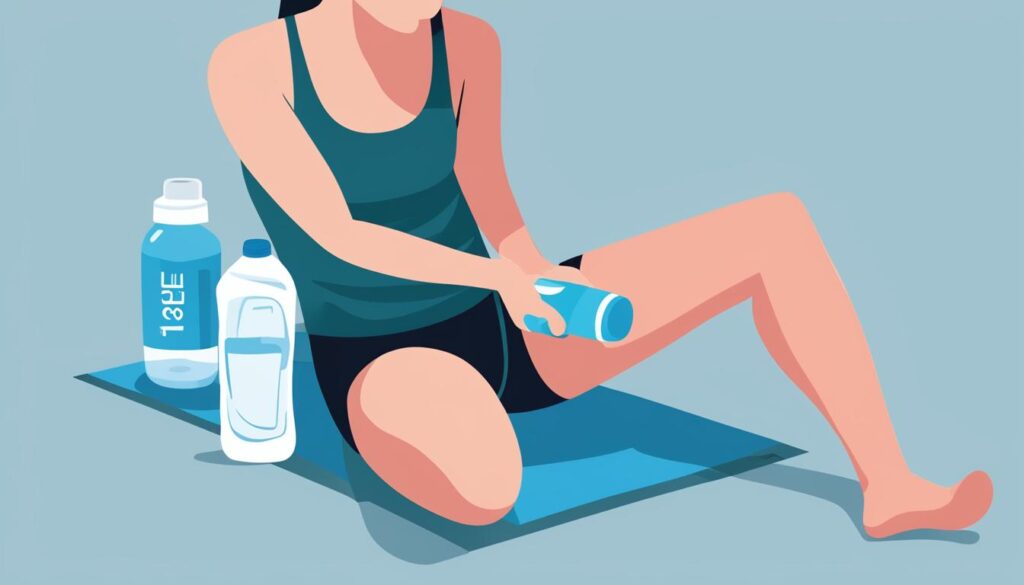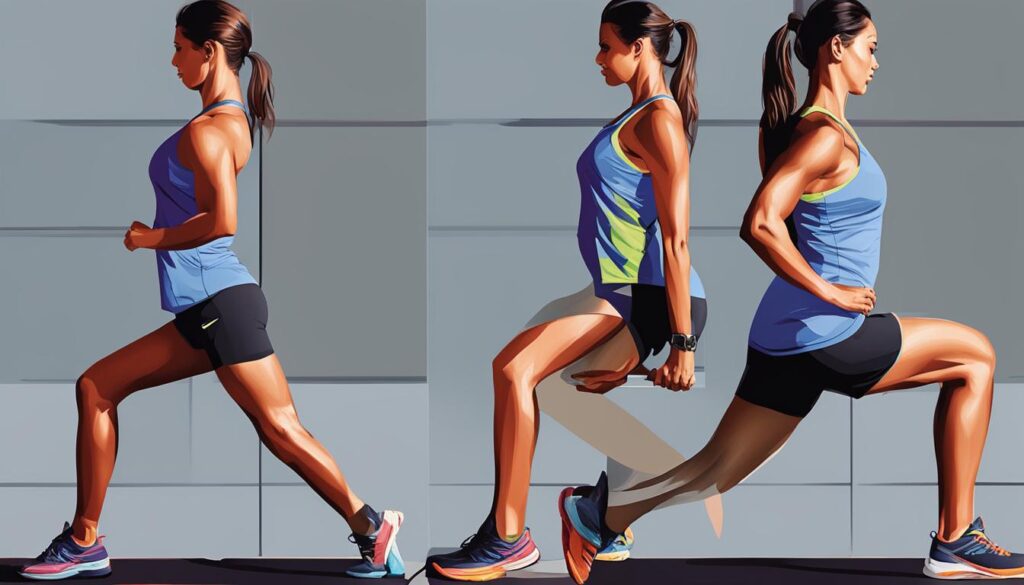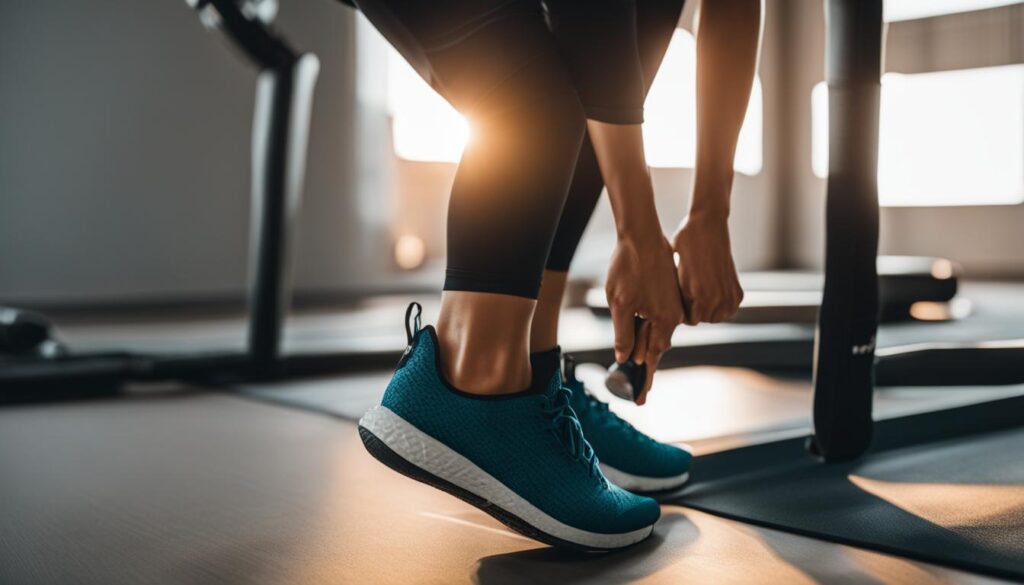Are you struggling with leg cramps, seeking instant relief, or better yet, effective ways to prevent them? You’re not alone. Many of us experience leg cramp discomfort daily, with middle-of-the-night cramps being particularly bothersome. The good news is that there are effective leg cramp relief options accessible to everyone. To demystify leg cramp remedies, this article dives into the common causes, tips for instant relief, and preventive measures anyone can follow to keep leg cramps at bay.
The strategy for dealing with leg cramps should ideally start with understanding the situation. Why are the cramps happening? What factors could be exacerbating them? With a clear understanding of the why, we can then move to how – how to prevent leg cramps and make them a lesser issue in your life. This article aims to make it all more understandable for you.
Now, before we delve in, let’s sum up some important points that will be covered in this detailed guide on leg cramp remedies.
Key Takeaways
- Understanding the common causes of leg cramps is the first step to effective prevention and treatment.
- Keeping well-hydrated and maintaining a balanced diet is crucial in preventing leg cramps.
- Practicing regular stretching exercises can help alleviate and prevent muscle tension that leads to cramps.
- Applying heat or cold, massaging, and taking some medications can provide instant relief for leg cramps.
- Essential minerals like potassium and magnesium play a significant role in preventing muscle cramps.
- Physical exercises and proper techniques can reduce the risk of cramps, especially for those who are frequently involved in high-intensity workouts.
Understanding Leg Cramps and Their Common Causes
Leg cramps are a common issue faced by many, causing unexplained pain and discomfort. These painful contractions or spasms happen in one or more of your muscles can occur in various body parts, from your hands to the thigh. They often affect older adults, pregnant women, and those with prevalent nerve disorders or experiencing muscle overuse. But, to fully explore the natural remedies for leg cramps, it’s vital first to understand their potential causes.
Identifying Different Types of Leg Cramps
Contrary to popular belief, not all leg cramps are the same. There’s a broad classification based on their causatives, which include exercise-induced cramps, nocturnal cramps (occurring during sleeping hours), and rest cramps, which could onset during rest periods after strenuous physical activities.
Exploring Factors That Contribute to Muscle Cramping
While the exact leg cramp causes might vary, some common factors contribute to muscle cramping. These include an improper balance between muscle relaxation and contraction, prolonged immobility, and even certain drugs like diuretics, which result in a rapid loss of minerals and fluids.
Recognizing the Role of Dehydration and Mineral Deficiencies
Speaking of fluids, dehydration is a significant cause of muscle cramps, especially for those who exercise regularly and don’t replenish their fluid intake. Not only does this lead to muscle fatigue, it exacerbates muscle contraction and cramping. Likewise, a deficiency in vital minerals such as calcium, sodium, and magnesium can disrupt nerve impulses, leading to cramps. Noticeably, diuretic use could cause sodium and chloride deficits, making muscle cramps all too common for regular users.
| Predominant Causes | Effects |
|---|---|
| Improper muscle relaxation | Leads to tense, cramped muscles |
| Dehydration | Causes muscle fatigue, exacerbating instances of cramping |
| Extended immobility | Reduces blood flow, thereby increasing cramp occurrence |
| Mineral deficiency | Disrupts nerve impulses, leading to cramps |
As discussed, several factors contribute to the prevalence of leg cramps, but luckily, several natural remedies can help soothe those aching muscles.
Immediate Actions to Alleviate Leg Cramps
Leg cramps can be excruciating and formidable, requiring quick and effective solutions for instant relief. If you’re puzzled about how to stop leg cramps on the spot, we’ve got you covered.

First and foremost, stretching the afflicted muscle can be one of the most immediate soothing remedies for leg cramps. Gently pull the muscle in counter to the cramp and hold that position. This simple action can relieve the painful tension that is causing discomfort.
Another quick leg cramp remedy is massaging the affected area. Gently running your hands over the cramped muscle can assist in relaxing it, thus providing relief.
- Heat application: Using warm towels or heating pads, or taking a hot bath shower, can aid in achieving muscle relaxation. The heat penetrates deep into the muscle, increasing blood flow and soothing away the cramp.
- Cold therapy: After attaining initial muscle relaxation, using a cold compress can be incredibly beneficial in soothing the pain. The cold can numb the pain, providing a welcome relief from the discomfort.
Remember, seeking immediate medical attention is crucial if your cramp is accompanied by severe discomfort or swelling.
Note: Every individual will react differently to these remedies. While these are general measures to alleviate leg cramps for most people, they might not work for everyone. Always consult your healthcare provider when unsure.
Leg Cramp Remedies: In-Depth Look at Quick Relief Techniques
When confronted with the discomfort of leg cramps, home remedies often provide immediate relief. Techniques such as stretching, heat therapy, and applying a cold compress can help alleviate muscle tension and are easy to employ at home. It’s always best to take a moment for self-care, using these methods to help your body relax and recover.
Stretching: Best Practices for Easing Muscle Tension
Stretching is a powerful tool in the relief and prevention of leg cramps. If a cramp strikes in your calf, try to keep your leg straight and gently pull your foot towards your face. For cramps in the thighs, pulling the foot up towards the buttock can help. Emphasizing slow, controlled movements can prevent further pain or injury. Remember to breathe deeply throughout, promoting circulation and relaxation in the distressed muscles.
Heat Therapy: Aiding Muscle Relaxation
Another effective technique for muscle tension relief is heat therapy. Applying a heating pad or immersing oneself in a warm bath can significantly help soothe tight muscles. The warmth increases circulation, allowing nutrients to flow into the muscle and waste products to flow out, promoting faster healing. If a heat source is ready at hand, this can be an ideal remedy to turn to for quick relief.
Cold Compress: Benefits and Limitations for Cramp Relief
Just as applying heat can be helpful, so too can a cold compress for cramps. Though it may seem a bit counterintuitive at first, cold therapy can play a crucial role after the initial muscle relaxation has taken place. The cold helps to numb the area and is particularly effective in easing any lingering ache. It’s essential to remember that the cold compress should not be applied directly to the skin, but rather wrapped in a thin towel or cloth to prevent skin damage.
| Treatment Technique | Benefits | Limitations |
|---|---|---|
| Stretching | Provides immediate muscle tension relief and helps in prevention | Requires knowledge of specific stretches |
| Heat Therapy | Increases circulation, aids in muscle relaxation | May not be immediately accessible |
| Cold Compress | Numbs the affected area, easing lingering post-cramp pain | Should only be used after the initial muscle relaxation phase |
Hydration and Nutrition: Keys to Preventing Leg Cramps
It has long been known that there’s a significant connection between a person’s nutrition and hydration status and the occurrence of sleep-shattering leg cramps. Particularly, proper hydration paired with a well-balanced diet plays a pivotal role in maintaining electrolyte balance and reducing irritation in muscle cells, thereby preventing leg cramps.
Optimizing Fluid Intake for Muscle Health
Proper hydration for leg cramps involves not just drinking adequate amounts of water but also replacing lost electrolytes. A well-hydrated body is key to keeping your muscle cells healthy and functioning optimally, thereby making cramps less likely. It’s advised to increase fluid intake particularly during high-intensity exercise, hot weather, or when suffering from gastrointestinal illnesses that cause vomiting or diarrhea.
Electrolytes and Their Impact on Muscle Function
Electrolytes are minerals that carry an electric charge and play an instrumental role in maintaining fluid balance in our bodies. The primary electrolytes needed for proper muscle function are potassium, calcium, and magnesium. An electrolyte imbalance due to poor diet, chronic disease, or excess sweating through exercise can lead to muscle cramps along with other health concerns. Hence, maintaining an electrolyte balance is paramount in preventing leg cramps.
Dietary Adjustments to Mitigate Cramping Episodes
To effectively prevent leg cramps through nutrition, one might need to implement some dietary changes for muscle health. Consuming a balanced diet that includes foods rich in potassium, calcium, and magnesium can help prevent electrolyte imbalance and muscle cramps. Foods such as bananas, oranges, spinach, and seeds are rich in these minerals. Also, reducing intake of caffeinated and alcoholic beverages, which can lead to dehydration, might also prove beneficial.
Home Remedies and Natural Supplements for Leg Cramps
When it comes to dealing with leg cramps, home remedies and natural supplements can offer immense relief. Be it magnesium or potassium, their power in pain relief and cramp prevention cannot be understated. The use of Epsom salts also brings with it a soothing relief, while essential vitamins and herbal treatments are instrumental for overall muscle care. Let’s delve into these in more detail.
The Power of Magnesium and Potassium in Cramp Prevention
Boosting muscle health and providing respite from relentless leg cramps, minerals like magnesium and potassium are a must-have in your diets. Great sources of these minerals include nuts and seeds. However, for those needing a bigger health kick, supplements can provide the extra support needed.
Using Epsom Salts for Soothing Muscle Relief
With its rich magnesium content, Epsom salts could turn out to be your trusted companion on restless nights. An effective remedy for leg cramps, these can be applied through a wet cloth or added to a hot bath. The warmth enhances the absorption of magnesium, leading to almost instant relief.
Essential Vitamins and Herbal Treatments for Muscle Care
Aside from minerals, vitamins, particularly the vitamin B complex, play a crucial role in the prevention and management of leg cramps. While herbal treatments add an extra layer of care, it is important to consult with your health care provider before embarking on any new supplement regime.
Now, let’s take a brief look at some popular natural supplements for leg cramp relief, how they work, and their sources.
| Natural Supplement | Mechanism of Action | Source |
|---|---|---|
| Magnesium | Essential for muscle and nerve function, helps prevent leg cramps | Nuts and seeds, legumes, tofu, whole grains |
| Potassium | Helps maintain electrolyte balance, necessary for proper muscle contractions | Bananas, oranges, cantaloupes, sweet potatoes |
| Epsom Salts | Enriched with magnesium, relaxes muscles when absorbed through the skin | Epsom salts bath or topical application |
| Vitamin B Complex | Supports nerve function and muscle health | Whole grains, beans, peas, nuts, eggs |
Always remember, while these natural supplements for leg cramps have their benefits, their misuse can lead to serious health issues. Therefore, always seek professional advice before making drastic changes to your diet or supplement routine.
Physical Activity and Stretching: Long-Term Strategies
When it comes to managing leg cramps, a well-rounded approach is essential. This includes a mix of immediate relief actions and long-term preventive measures. In this section, we’ll discuss the significance of consistent physical activity and developing a purposeful stretching routine for your legs, exercise modifications to ward off cramps, and the importance of adhering to proper exercise techniques. These strategies not only aid in reducing leg cramps risk but also support overall muscle health and flexibility.

Developing a Stretching Routine to Support Muscle Flexibility
Regularly engaging in a targeted stretching routine for legs enhances muscle flexibility. Flexible muscles are less likely to contract involuntarily, thereby potentially reducing the risk of leg cramps. Whether it be hamstring stretches, calf stretches, or foam rolling exercises, it’s vital to include a variety of stretches that target all the lower-body muscles.
Exercise Modifications to Reduce the Risk of Cramping
Minding how you exercise is as vital as the exercise itself. Integrating exercise modifications in your fitness regime can significantly reduce the potential strain on muscles and thereby, lessen the risk of cramping. This might involve adjusting the intensity of your workouts, incorporating rest periods, or switching to low-impact exercises.
Understanding the Importance of Proper Exercise Techniques
Implementing proper exercise techniques is fundamental in preventing leg cramps. It’s not just about the exercises you do but how you do them. Paying attention to proper form, investing time in warm-ups and cooldowns, maintaining control during movements, and gradual progression are key aspects to ensuring effective and safe workouts. Improper technique can impose undue stress on muscles, resulting in cramps or injuries.
If consistent stretching and regular physical activity don’t seem to reduce the frequency or severity of your muscle cramps, professional assistance—like massage or medial advice—may be warranted. Remember, sustainable relief from muscle cramps comes from a blend of instant soothing methods and preventive long-term strategies.
| Strategy | Description |
|---|---|
| Stretching Routine | A consistent routine that focuses on all lower-body muscles to boost flexibility and reduce cramps risk. |
| Exercise Modifications | Alterations in workout intensity and technique to decrease strain and overuse of muscles. |
| Proper Exercise Techniques | Adherence to correct form, control, warm-ups, and cooldowns during workouts to prevent muscle cramps. |
Conclusion
As we reach the end of our discussion on leg cramp remedies, it becomes evident that a multifaceted approach is required for both immediate and effective leg cramp relief. The gamut of remedies we explored includes stretching exercises, heat or cold applications, maintaining optimal hydration levels, ensuring an adequate intake of essential minerals, utilizing home remedies such as Epsom salts, and engaging in regular physical activity which includes proper stretching techniques.
Of these, maintaining a consistent focus on hydration and nutrition is crucial. Our bodies are a complex network, where the balance of fluids and essential nutrients plays a significant role in muscle functioning. As such, a regular and balanced intake of key minerals like magnesium and potassium can help us mitigate the frequency of cramping episodes, presenting a natural way to stop leg cramps.
Moreover, taking note of proper exercise techniques, and integrating strategic modifications in our physical activities can help reduce the risk of muscle strain and overuse – a common cause of leg cramps. Importantly, it is advisable to consult with healthcare providers before commencing any new supplement regime or making major modifications to your exercise regimen. Persistence of symptoms despite these remedies calls for professional medical consultation to decipher potential underlying issues and consider appropriate leg cramp treatment options.





